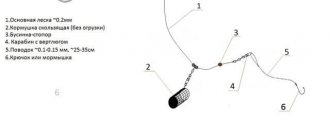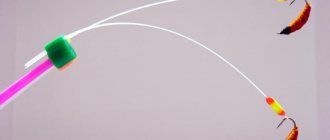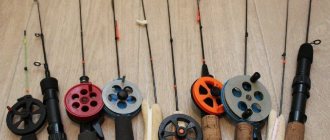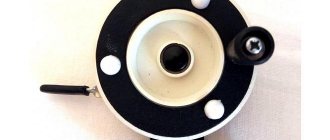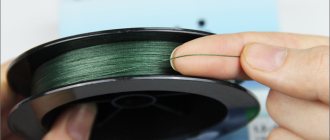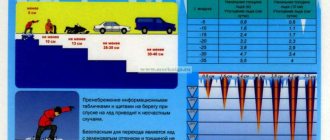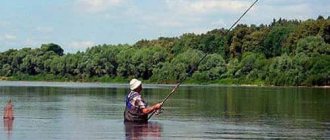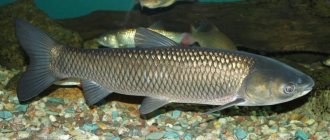Fishing Rods Review
05 February
Review of nodular winter fishing rods
Winter fishing is a gambling and exciting activity. However, it happens that in a whole day you manage to catch only two or three small perches. This is often explained not by a bad bite, but by the low sensitivity of gear, which does not respond to bites from sleepy and cautious fish. The problem is solved by nodular fishing rods, which react sensitively to the lightest touches of the jig. These are nozzle forms that have a number of features. What are they?
What is a nodless fishing rod?
A noduleless fishing rod for a reelless fish is a flexible 30 cm whip with a line storage.
It is distinguished by: simplicity of design, light weight up to 10 grams.
pros
- The angler's hand is directly connected to the bait through a thin fishing line, which allows for better control of the game and the slightest bite.
- There is no need to constantly monitor the tip of the nod to detect a bite.
- Possibility of instant reaction to a bite.
- The fishing rod is not subject to wind loads.
- The simplicity of the design implies ease of self-production.
Minus
It is impossible to create a universal whip that can cover the entire range of play.
Algorithm for selecting structural elements for a rewinder
The choice begins with the selection of fishing equipment for the weight of the reelless reel. The diameter of the fishing line should be such that under the weight of the jig the fishing line would stretch into a straight line.
Recommendations
- Mormyshka 0.2-0.25 g.
- fishing line 0.06 – 0.08 mm;
- the total weight of the tackle with wound fishing line is 2-3 grams;
- fishing depth up to 5 m;
- fish weight up to 150 g.
- Mormyshka 0.25-0.5 g.
- fishing line 0.08-0.1 mm;
- the total weight of the tackle with wound fishing line is 3-5 g;
- fishing depth up to 8 meters;
- fish weight up to 200 g.
Mormyshka 0.5-0.8 g.
- fishing line 0.1-0.12 mm;
- the total weight of the tackle with wound fishing line is 5-7 g;
- fishing depth up to 12 m;
- fish weight up to 300 g.
Expert opinion
Knipovich Nikolai Mikhailovich
Zoologist, hydrobiologist. I am interested in fishing at a professional level.
Important! At such a depth, using a fishing line in the form of a reel is not very convenient. It is preferable to use a coil.
- fishing line 0.12-0.16 mm, large spool;
- tackle weight up to 10 g;
- depth up to 15 meters;
- fish weight up to 2 kg.
Whip selection
You can only be guided by the following considerations:
- To create a high-frequency, low-amplitude game, the whip is chosen to be short and hard. Although you can create such a game with a thin long whip, if you get into the resonance of the movement of the whip and jig - a resonant game;
- The greater the fishing depth, the higher the water resistance, the stiffer the whip should be.
Expert opinion
Knipovich Nikolai Mikhailovich
Zoologist, hydrobiologist. I am interested in fishing at a professional level.
Important! The choice of a whip is an experimental matter, depending on the subjective feelings and preferences of the angler.
With booty
Of course, the resulting fishing rod is very primitive, but it has obvious advantages. It’s practically free, you don’t need to buy anything except a fishing line and a jig, and for example, you can make a good fly jig yourself, with your own hands. The fishing rod is quite light and durable, fits comfortably in the hand. Changing a jig to a more catchy one happens quickly thanks to the large stock of fishing rods.
Polyakov Yuri Nikolaevich - Specially for the SamodelkiFish website, Nizhny Novgorod, Russia
- Homemade fishing rods for baitless, reelless fishing rods. Short review.
- Do-it-yourself winter fishing rod for a reelless reel (with a reel)
Design of a noddle-less fishing rod for reelless fishing
Whip
It is selected depending on the weight of the jig and the desired method of play. A whip in the form of interchangeable tips for various fishing rods can be purchased at a fishing store.
Hollow
For pulling fishing line inside the whip. You can use a carbon tip on a fly or feeder rod.
At the end of the whip, a short cambric is put on, protruding half a millimeter beyond the edge of the whip, which serves to prevent friction of the fishing line on the carbon.
As a cambric, you can use a piece of electrical wire insulation, placed on the tip of the tip in a heated state.
Pros:
- the load is distributed evenly along the axis of the whip;
- withstands heavy weight.
Minus:
Moisture getting inside the whip (when winding the fishing line onto a reel or when lowering the fishing rod onto the snow) can lead to the formation of ice. The whip will need to be warmed up.
Whole
A PVC tube is attached to the end of the whip. The fishing line is pulled along the whip and wound into a PVC tube.
Pros:
- the ability to replace the rod without dismantling the equipment;
- quick replacement of whips.
Minus:
A one-piece whip requires the presence of passage rings, which makes the structure heavier.
Replaceable whips
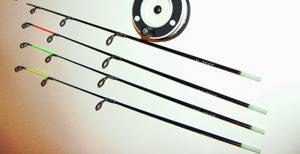
To create replaceable whips, the passage rings located on it are made with a slot for easy removal of the fishing line.
The PVC tube is removed from the top, the fishing line is removed from the guide rings through the slots. The whip is removed from the blank channel.
A PVC tube is put on the new tip, through which the fishing line has already been passed. The fishing line is threaded through the slots into the passage rings. The tip is inserted into the channel.
Minus:
The PVC tube at the end of the tip prevents the free flow of the fishing line. Passage rings slightly increase the weight of the gear.
Timber storage
- Reel for a filly-type winter fishing rod. Foamed pvc, polystyrene foam.
- Champagne cork.
- Shcherbakov's puck. Foam plastic, foamed pvc.
- The top of a plastic bottle with a wide neck.
- Reel with friction clutch.
- Axleless design.
Nod
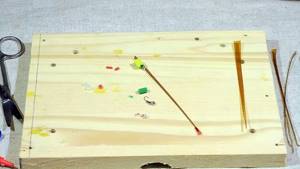
This element can be called the most important part of a reelless fishing rod. It primarily determines how correct the bait will work and how attractive it is to the fish. Nods for fishing with reelless bait are sold in fishing stores, but almost all enthusiastic fans of this kind of fishing prefer to make them themselves.
Almost every experienced bleeder has his own technology for making nods that perfectly suit his requirements.
Mylar nod
Lavsan nods for reelless fishing are the best choice for baitless fishing. They work well at retrieving bait, and also show good bites. The best option is a narrow nod made of thick, 0.4-0.5 mm, lavsan. It is rigid and therefore works optimally.
Plastic nods
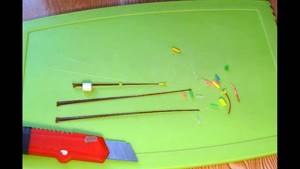
They are made from plastic bottles or cups. It is enough to cut a strip, and then, if desired, grind it onto a cone. The materials of different bottles and cups can vary greatly, so choose them carefully.
X-ray film nods
X-ray film is another material that can replace lavsan. The technology for making the gatehouse is the same.
Metal nods
They are made from clock springs or old tape measures. The advantages of such a gatehouse are durability and indestructibility. The disadvantage is that steel is difficult to machine and making a nod out of it is not easy. In addition, the metal guard is rough; it is only suitable for fishing with heavy jigs.
Boar bristle gatehouses
Very convenient when wiring, shows good bites. The disadvantage of these nods is that boar bristles are difficult to obtain. Therefore, today it is almost never used in fishing.
Nods from fishing line
For their manufacture, thick monofilament with a diameter of 0.5 mm is used. Such nods are similar in design to boar bristle nods, but are inferior in performance characteristics.
Rubber nipples and coiled springs should not be used when making nods for reelless fishing. It is impossible to make proper guards out of them that will ensure comfortable fishing.
Straight and conical nods
Conical nods made of lavsan, x-ray film or plastic bottles work better than straight ones.
There are two ways to taper this piece of gear:
- cone in width - you need to trim the nod so that its end is narrower than the base;
- cone in thickness - it is necessary to grind the nod so that its end is thinner than the base.
It is the taper in thickness that provides the nod with a certain play, so you need to pay attention to it. To sharpen a lavsan nod, you need to rub sandpaper along the very tip 5 to 10 times, then the same number of times from the middle to the tip, and then the same number of times along the entire length of the nod. Thus, this procedure is not at all complicated, and it will not take much time.
Setting the nod
There are three main options for nod placement for reelless fishing:
- Curved. The nod must be bent so that it forms one line with the fishing line. In this case, it is quite easy for the rewinder to set high-frequency play.
- Straight. Such a nod without load forms one line with the six, and bends under load. It is well suited for shallow water fishing.
- Curved upward. Such guards look up without load, and straighten out under the weight of the jig. The advantage of such a nod is that it smoothes out errors in the game well.
How to make it yourself
From a purchased balalaika
Designed for catching fish weighing up to 2 kg with reelless baits up to 2 g (witch, devil, etc.) at a depth of up to 15 m.
Tool:
- Drill.
- A wood drill with a diameter equal to the maximum diameter of the whip.
- Needle file.
Materials:
- Purchased winter balalaika fishing rod.
- Carbon whip of the required diameter and length:
- for a rewinder - a short hollow flexible whip 30 cm;
- for luring - a hollow hard whip 50 cm.
- 0.6-0.12 mm 15 m for mothless;
- 0.1-0.18 mm 30 m for winter spinners.
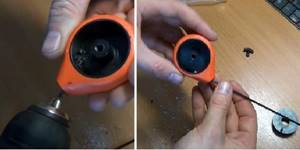
Instructions:
- The purchase form is dismantled.
- The coil is disassembled and removed.
- A hole is drilled in the place where the whip is attached at such an angle that the line from the reel fits into the channel of the whip without bending.
- A hollow carbon whip of the required length is cut and flared with a needle file on both sides.
- The seat of the whip in the balalaika reel seat is coated with “moment” or EDP glue.
- The whip is installed in the reel seat with slow rotation.
- After the glue has dried, sagging and irregularities are smoothed out with a file and sandpaper.
- The fishing line from the reel is threaded through the top of the whip into the channel, pulled to the reel, secured with a knot and the required amount of fishing line is wound onto it.
- A cambric of electrical wire insulation is placed on the tip of the whip. The inner diameter of the insulation should match the diameter of the tip of the whip. First, you should heat the insulator, then pull it onto the tip of the whip so that the insulator extends 0.5 mm beyond the whip.
With Shcherbakov's puck
Tool:
- shoe knife;
- needle file;
- sandpaper No. 1;
- screwdriver;
- wood drill;
- circular drill (a hollow cylinder with teeth and a drill in the center);
- round and flat files with fine cuts.
Material:
- foam block;
- the whip of the required length is hollow or solid.
The Shcherbakov washer is a hollow cylinder with a circular channel for storing fishing line.
The channel for the fishing line is bored at an obtuse angle for unhindered convergence of the fishing line under load. Designed as a friction brake to control the landing of large fish.
By holding the fishing line in the channel with your finger, you can adjust the convergence force of the fishing line.
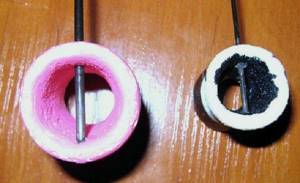
Instructions:
- A washer of the required diameter and the required length is cut out of the foam block using a circular drill.
The washer naturally produces an internal channel from the central wood drill. If desired, the channel can be expanded. - A through hole is drilled in the upper part of the cylinder body perpendicular to the axis of the washer for attaching the whip.
- At the bottom of the cylinder, a channel for storing fishing line is machined with a round file.
- Pseudo-friction works when using a solid whip with guide rings.
The bottom of the channel is processed with a flat file to form an obtuse angle for easier convergence of the line. For the same purpose, the channel is sanded and varnished or painted with nitro paint. - In the case of using a hollow blank, the circular channel is not processed with a flat file, but in this case the pseudo-friction does not work, since the fishing line is inserted into the channel of the whip.
- The irregularities of the washer are processed with sandpaper.
- A whip coated with glue is inserted into the channel.
Expert opinion
Knipovich Nikolai Mikhailovich
Zoologist, hydrobiologist. I am interested in fishing at a professional level.
Comment. When using a hollow whip, the Shcherbakov washer acts like a large plug. For fishing with heavy jigs at great depths, this may be a viable option.
Kickless fishing rod for pike perch
Zander. Powerful blow when biting. Bony plates in the mouth that are difficult to pierce.
Equipment requirements
- whip - hard, durable;
- sharp hook Owner.
Design
- Handle 10-12 cm.
Purchased at a fishing store or carved from wood.In a homemade handle, a deep hole is drilled along the axis (30-50% of the length of the handle) for attaching the form.
- The reel is a commercial one of large diameter with a friction clutch. Located on the top of the handle. Secured with electrical tape.
- Hard strong form length from 30 to 40 cm with passage rings.
In this design, you only need to perform two actions:- insert the form with glue into the hole in the handle;
position the guide rings correctly.
Since it is recommended to install the reel on top of the handle, and the line is directed downwards, the guide rings must be installed yourself.
Passing rings
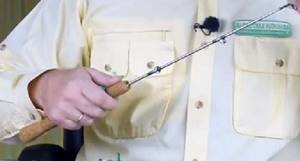
The first ring next to the handle is set at a zero angle for direct line entry.
The second ring is installed at an angle of 45°.
The third ring is installed at an angle of 90°.
Fastening the pass rings
The rings are attached to the rod with harsh threads, turn to turn, and coated with EDP-based varnish.
Universal no-kick fishing rod
A commercial fishing rod with a strong handle, an open reel, and a channel for mounting the blank is used.

Manufacturing:
- Forms are prepared from purchased tips of 40-50 cm for spinning rods with guide rings (it is enough to have 5-6 tips of different lengths, different diameters to ensure a variety of jig play and for trolling).
- Using a circular drill (a hollow cylinder with teeth) from hard rubber, posts with a diameter equal to the diameter of the channel for mounting the form and a length equal to the length of the channel are drilled.
- Using a thin drill, a hole is drilled in the center of the rubber post for mounting the top.
Instead of a purchased form, you can insert various tips with rubber knobs. - On the opposite side of the reel, closer to the edge of the handle, a strap is secured with a screw.
Operating principle when fishing with a jig:
- The fishing rod is fastened to the hand with a strap so that the fingers can wrap around the beginning of the tip. The game is played by oscillating the tip with your fingers.
- The strap holds the heavy part of the fishing rod and prevents it from participating in the game.
- When a bite occurs after hooking, the rod rises as high as possible, the other hand intercepts the line, the rod moves to the side and allows the second hand to participate in pulling the fish.
Coil
Before buying a fishing rod, check how smoothly and easily the reel rotates and whether the stopper works well. This element of the tackle does not take part in fishing, so there is no need to make serious demands on it. For reelless fishing, reels made entirely of plastic and without metal parts that freeze in the cold are suitable.
The spool axis can be lubricated with lard to make it rotate more easily. This unique lubricant does not freeze in the cold and ensures reliable, uninterrupted operation.
